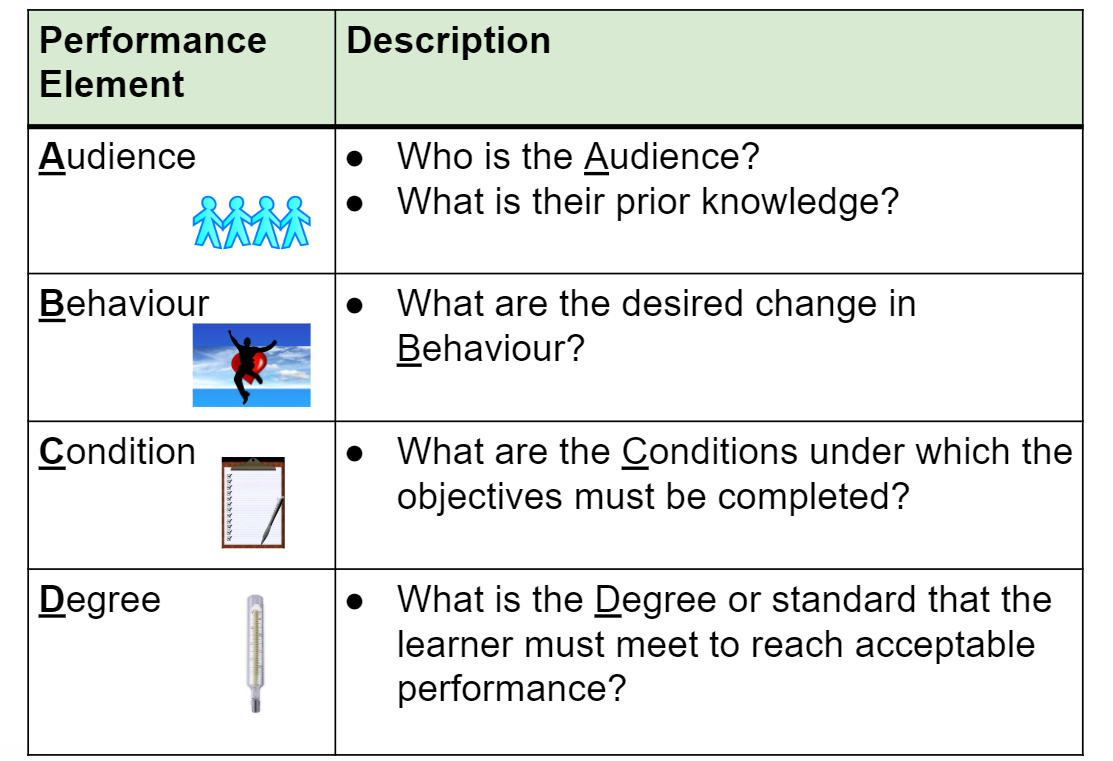BUILDING YOUR COURSE: HOW DO I GET STARTED?
STAGE 1- START WITH THE END IN MIND
Start by your getting hands on a course outline template (click here for a sample). You can contact your school manager, course coordinator, area coordinator or relevant programme director to have a course outline template specific to your school. Although there may be slight variations in what is required for different schools, all course outlines typically start with a description of the course, and its intended learning outcomes.
At this stage, you define:
- The course description
- The course learning objectives, i.e. what students should know, understand and be able to do by the end of the course
CTE recommendation: Writing measurable learning objectives
A clear and measurable learning objective has four distinct performance elements: Audience, Behavior, Condition and Degree (ABCD) (Smaldino, Lowther & Russell, 2007). This is a good starting point on coming up with measurable learning objectives.
Figure 1. ABCD model for writing learning objectives

Figure 2. Example of a learning objective written using the ABCD model

Biggs and Tang (2011) recommend having no more than five or six intended learning objectives, for a semester-long course. A set of five or six well-crafted course learning objectives communicates a holistic overview of the course. Any more than five or six course learning objectives will make it difficult for the instructor to align his/her teaching and learning activities and assessment tasks to each (p. 119).
The Bloom’s Revised Taxonomy (Anderson & Krathwohl, 2001) provides a useful resource on the action verbs for writing learning objective in specific and measurable language. Once you have the learning objectives articulated, you will find it easier to align your assessment methods (Table 2) and instructional strategies (Table 3).
Table 1. Thinking Levels of the Bloom's’ Revised Taxonomy1
|
Thinking Level |
Description Action Verbs |
|---|---|
| Remember |
Recognising or recalling knowledge, facts or concepts. Verbs: define, describe, identify, know, label, list, match, name, outline, recall, recognise, reproduce, select, state, locate |
| Understand |
Constructing meaning from instructional messages. Verbs: illustrate, defend, compare, distinguish, estimate, explain, classify, generalise, interpret, paraphrase, predict, rewrite, summarise, translate |
| Apply |
Using ideas and concepts to solve problems. Verbs: implement, organise, dramatise, solve, construct, demonstrate, discover, manipulate, modify, operate, predict, prepare, produce, relate, show, solve, choose |
| Analyse |
Breaking something down into components, seeing relationships and an overall structure. Verbs: analyse, break down, compare, select, contrast, deconstruct, discriminate, distinguishes, identify, outline |
| Evaluate |
Making judgments based on criteria and standards. Verbs: rank, assess, monitor, check, test, judge |
| Create |
Reorganise diverse elements to form a new pattern or structure. Verbs: generate, plan, compose, develop, create, invent, organise, construct, produce, compile, design, devise |
1 Anderson, L. W., & Krathwohl, D.R. (2001). A taxonomy for learning, teaching, and assessing, Abridged Edition. Boston, MA: Allyn and Bacon.
Put into practice: Completing your course outline document
|
COURSE DESCRIPTION
*The graduate learning outcomes refer to the university-wide highest learning goals that are important for all undergraduates. |
| LEARNING OBJECTIVES Learning objectives are specific statements about the key knowledge and skills that students will acquire after completing your course. They should be observable and measurable such that students are able to demonstrate and that you can assess. Craft learning objectives using the list of action verbs from the Bloom’s Revised Taxonomy (Table 1) and present them as follows: |
|
By the end of the course, students should be able to:
|
Bibliography
- Anderson, L. W., Krathwohl, D. R., & Bloom, B. S. (2001). A taxonomy for learning, teaching, and assessing: A revision of Bloom's taxonomy of educational objectives. Allyn & Bacon.
- Biggs, J., Tang, C., & Society for Research into Higher Education. (2011). Teaching for Quality Learning at University : What the Student Does , Philadelphia, Pa. : McGraw-Hill/Society for Research into Higher Education ; Maidenhead, Berkshire, England ; New York : Open University Press. (Available for loan from SMU Libraries)
- Smaldino, S. , Lowther, D. and Russell, J. (2007) Instructional Media and Technologies for Learning, 9th Edition. Englewood Cliffs: Prentice Hall, Inc.